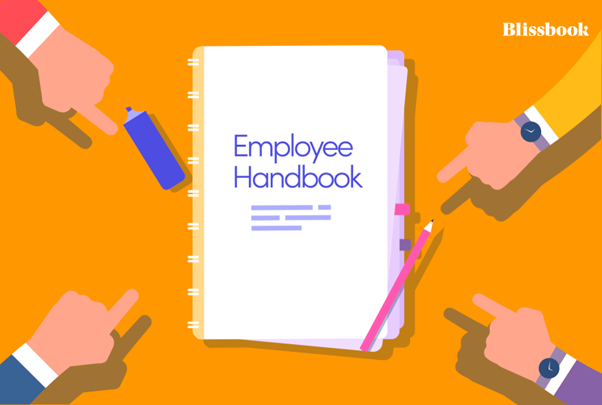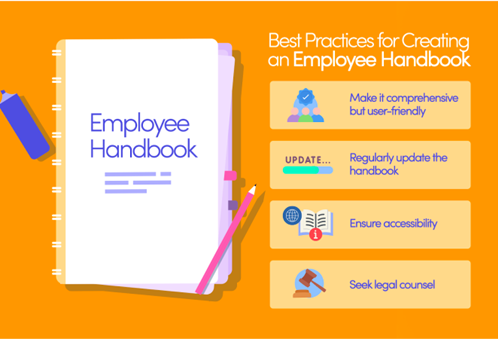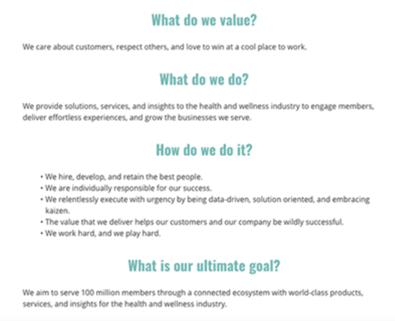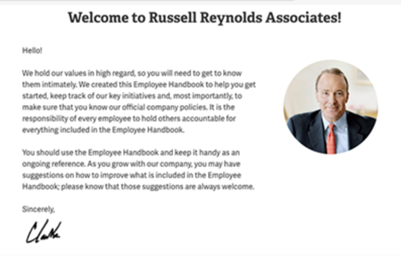What is an Employee Handbook?
Are you creating your first handbook or overhauling an outdated handbook? No matter where you are on this journey, it’s important you understand the employee handbook basics.
When done effectively, an employee handbook is one of the most valuable items in your HR toolkit. It’s more than a mere list of dos and don’ts; it’s a comprehensive guide that can set your organization up for success.
We’ll explain why you need an employee handbook, how to structure your handbook, and ways to implement your handbook. Let’s get started!
Employee Handbook Definition
An employee handbook is a comprehensive document that outlines a company’s policies, procedures, principles, and work standards. A handbook is often considered the cornerstone of an organization’s communications strategy.
Your employee handbook should identify your organization’s internal rules and culture. It’s also a reference for employees who have questions about the company’s guidelines and ethics.

Here are a few main goals of an employee handbook:
- Set expectations: Your handbook should define what you expect from your employees and what they can expect from you. Examples include outlining performance expectations and detailing the company’s commitment to a supportive work environment.
- Promote transparency: By documenting policies, benefits, and working conditions, employee handbooks promote transparency, ensuring employees have a clear understanding of their rights and responsibilities.
- Guide conflict resolution: An employee handbook guides managers and employees on preventing workplace conflicts and dealing with them if they occur.
- Cultivate culture: Your handbook is a platform to share the company’s mission, vision, values, and culture. It helps new hires and existing employees by explaining the company’s ethos and work environment.
- Protect the company: If issues of noncompliance arise, your handbook serves as a safety net. It shows that policies were communicated and distributed to employees.
Why is an Employee Handbook Important?
An employee handbook is a powerful tool that helps bridge communication gaps between employers and employees. By creating an employee handbook, you can foster a transparent, fair, and engaging work environment.
It serves as a legal shield for employers by helping mitigate risk. For instance, consider a case where an employee alleges wrongful termination. If you’ve plainly stated the company’s termination procedures and grounds for dismissal, you’ll be better prepared to defend your decision.
A handbook also promotes consistency in managing workplace affairs. When addressing tardiness, management can rely on the policy outlined in the handbook, ensuring every case is handled uniformly. This prevents potential claims of favoritism or discrimination.
For employees, the handbook is like a compass that helps them navigate the organization. It maps out their rights and responsibilities, sets performance expectations, and even explains how to raise concerns.
Imagine a new hire who feels uncomfortable due to a colleague’s inappropriate behavior. An effective handbook provides clear steps on how to report such incidents, ensuring the employee knows how to seek help within the organization.
What Does an Employee Handbook Include?
An effective employee handbook blends your organization’s policies and procedures with content that promotes legal compliance.
Legal Content
Everyone in your organization is legally obligated to comply with certain labor laws, and the best way to organize and communicate your policies about those laws is inside your employee handbook. This protects both your organization and your employees. Examples of policies that cover topics required by the law include:
- Equal employment opportunity policy, which affirms your company’s commitment to provide an equitable workplace free from discrimination. Federal and state laws make it illegal to treat employees unfairly based on certain protected characteristics, including age, race, and religion, to name a few.
- Anti-harassment policy, which defines the various types of workplace harassment, including sexual harassment and bullying, and the procedures for reporting harassing behavior. An anti-harassment policy also outlines how the organization will respond to allegations of harassment.
- Pregnancy accommodations policy, which outlines an employee’s rights under the Pregnant Workers Fairness Act. Employers with at least 15 employees are required to offer reasonable accommodations to individuals affected by pregnancy or related conditions.
- Family and Medical Leave Act (FMLA) policy, which provides employees with time away from work to address certain family and medical issues. Most organizations with 50 or more employees are required to provide employees with information about their rights under FMLA.
These are just a handful of policies that help convey legal obligations. Your employee handbook is a great way to communicate the steps your organization is taking to comply with the law. Depending on where your employees are located geographically, you may also need to include mandated policies for different states and jurisdictions.
Organization-Specific Content
Beyond the legal necessities, a top-notch employee handbook includes elements specific to the organization’s needs and culture:
- General company policies, which might include topics like attendance, dress code, and code of conduct.
- Employee rights and responsibilities, including detailed guidelines on what you expect from employees and what they can expect from the organization..
- Benefits and compensation information, such as explanations of your company’s benefits, pay procedures, and any bonus opportunities.
- Confidentiality and non-disclosure agreements, which protect companies and their clients by providing clear instructions on how to handle sensitive information.
While these elements create a robust employee handbook, remember to tailor the content to your organization’s unique culture and requirements. This will help you provide your employees with a useful and engaging resource.
4 Best Practices for Creating an Employee Handbook

Creating an effective employee handbook requires a balance of detailed information, readability, accessibility, and legal compliance. Here are some best practices to keep in mind during this process.
Make it comprehensive but user-friendly
Your handbook should cover all necessary topics while avoiding legalese and jargon. Strive for clarity and simplicity to ensure all employees, regardless of their background or role, can understand it. Break complex concepts down into easy-to-understand language, and consider using diagrams or infographics to make it more engaging.
Regularly update the handbook
Laws and organizational policies evolve. Make it a practice to review and update your handbook at least annually or whenever significant policy or legal changes occur. This helps keep your handbook current and relevant.
Ensure accessibility
All employees should have easy access to the handbook. It should be housed in a place that allows employees to refer to it whenever necessary, whether they’re on-site or remote.
Seek legal counsel
Before finalizing and distributing the handbook, have it reviewed by a legal expert. This ensures compliance with all current laws and can help protect your organization from potential legal issues.
Culture-First Employee Handbooks
A culture-first employee handbook embodies your organization’s values, spirit, and identity. It emphasizes company culture alongside policies, procedures, and expectations. Unlike a conventional handbook that primarily focuses on compliance, a culture-first handbook introduces the company’s mission, values, traditions, and even the little quirks that make the company unique.
A culture-oriented handbook helps shape a company’s culture by illustrating what the organization stands for and what it expects from employees. It promotes the practices and behaviors that align with the company’s core values, helping to build a cohesive and engaging work environment. It’s also a powerful tool for attracting and retaining talent.
For existing employees, a culture-rich handbook reinforces their sense of belonging and illustrates the company’s ultimate why, leading to increased job satisfaction and retention.
Examples of Successful Culture-First Employee Handbooks
It can be challenging to create a culture-first employee handbook that truly resonates with employees while illustrating what your organization is all about.
Here are a couple examples of culture-first employee handbooks.
1. Slalom

Slalom’s employee handbook incorporates testimonials from employees, which helps humanize the handbook. These quotes provide valuable insight that may resonate with other employees. This approach underscores Slalom’s commitment to its people, showcasing its culture-first philosophy.
2. actnano

Actnano’s employee handbook gives a comprehensive account of the company’s journey. This history teaches employees about the company’s roots and instills a sense of pride and belonging. By sharing its past and present, actnano fosters an inclusive culture where every employee feels valued and like an integral part of the company’s ongoing evolution.
3. Daxko

Software company Daxko’s employee handbook takes a culture-first approach by answering important questions about the company’s overarching goals. This promotes transparency and sets a shared vision, helping employees understand and connect with the company’s purpose. It establishes a culture of trust and collaboration, laying a strong foundation for a unified workforce.
4. Russell Reynolds Associates

The Russell Reynolds Associates handbook exemplifies a culture-first strategy, as illustrated by this welcome message from top leadership. This puts a face to a name and shows the company’s commitment to living its values.
Create Memorable Employee Handbooks with Blissbook
Creating an effective, engaging, and culture-first employee handbook is no small feat. It requires a blend of knowledge, creativity, legal insight, and a deep understanding of your organization’s ethos.
Remember that handbooks aren’t just about compliance. They can also inform and engage your employees by making them feel valued and like they’re part of a larger narrative.
This is where Blissbook comes into play.
Blissbook is a tool designed to make your employee handbook more than just a document. It allows you to craft a beautiful and interactive handbook that your employees want to read. Its user-friendly interface and customizable features make creating and updating your handbook smooth and efficient.
Sign up for a free trial to create your employee handbook today!
when one updates their employee handbook do you suggest marking the changes in an electronic copy and distributing internally?
Yes. Blissbook’s annotations feature is great for this. We also just wrote a new article entitled When Should Employees Re-Sign the Handbook? that dives into the situation you mentioned as well.